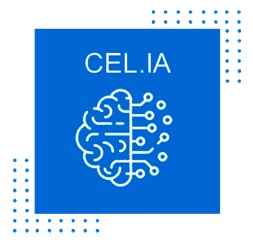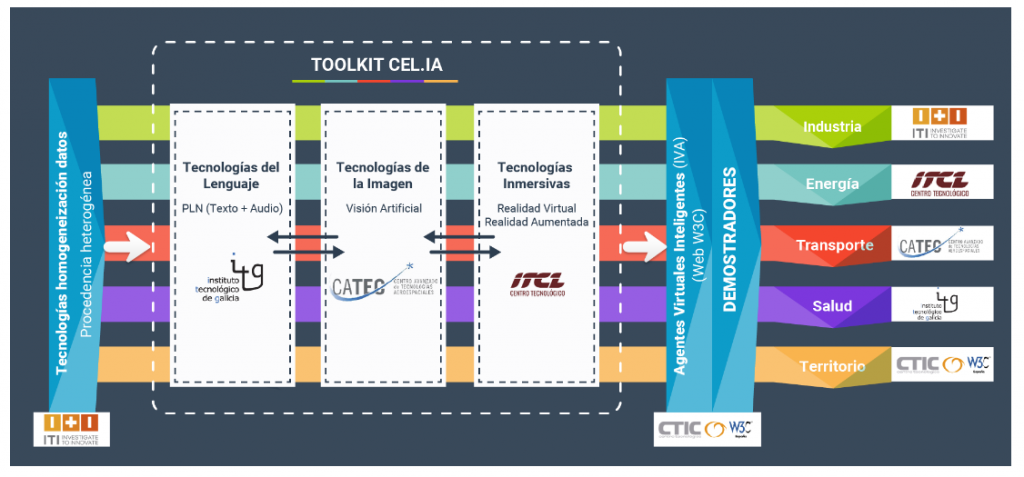Cervera Consortium for Leadership in R&D&I in Applied Artificial Intelligence
Project logo:

Cervera Center of Excellence
Financier:
Project (CER-20211022) recognized as a Cervera Center of Excellence, funded by the Ministry of Science and Innovation through the Center for Industrial Technological Development (CDTI), with funding from the 2021 General State Budget.

Partners
- 1 Information and Communication Technology Center – CTIC
- 2 Technological Institute of Galicia – ITG
- 3 Technological Institute of Castilla y León – ITCL
- 4 Institute of Information Technology – ITI
- 5 Andalusian Foundation for Aerospace Development – Advanced Center for Aerospace Technologies – FADA-CATEC
Summary
CEL.IA is a key instrument for achieving the maximum reach and impact of Artificial Intelligence on the Spanish economy and society. The CEL.IA Mission focuses its efforts on helping to overcome existing barriers and gaps so that end users (business and society) can incorporate Artificial Intelligence into their daily lives, developing, transferring, and applying solutions based on Cervera 21 Technologies (virtual and augmented reality, computer vision, and natural language processing) to address these needs.
During the project, a Toolkit will be developed, consisting of technological solutions resulting from collaboration among the Group’s members in the context of various AI-enabling technologies.

The developed Toolkit will technologically support five thematic application demonstrators, which will focus on the generation of Intelligent Virtual Agents for use cases in industry, energy, healthcare, transportation, and smart territories. CATEC is participating in the collaborative development of the technologies described above for all the demonstrators, with a broader focus on the transportation application field.
Furthermore, CEL.IA’s strategic program is structured around six objectives, which cover all dimensions of cooperation:
1) CEL.IA COLLABORATION NETWORK – Development of the aforementioned Toolkit of technological solutions for virtual and augmented reality, artificial vision and natural language processing, generated from a common technological roadmap built from the individual capabilities and competencies of each of the 5 Technology Centers.
CATEC coordinates the Imaging Technologies Work Line, which aims to analyze and develop a catalog of activities associated with Computer Vision techniques to expand expertise in Artificial Intelligence disciplines that enable deep image processing. This will allow for progress in the reconstruction and generation of 3D models, the implementation of Deep Learning in embedded devices for AR, as well as the detection and classification of objects, defects, and anomalies in images. The application of more efficient algorithms (Green AI) in image processing will also be studied.
In addition, CATEC is involved in lines of work related to Immersive Technologies, with the goal of exploring Mixed Reality and its real-time implementation in depth. The goal is to create tools aimed at improving telepresence and remote control of robotic systems through digital representations of the real world.
2) CONTINUITY MOTIVATION – Build a true and lasting collaboration network between centers, where capabilities, strengths and efforts are combined in other structural areas, fundamental for the correct development of solutions, such as technological surveillance and the identification of capabilities and competencies, in order to achieve the true synergistic effect of the Group working in a Network and ensuring its sustainability over time.
3) COMMUNICATION AND ACTIVE LISTENING – Promote direct contact with companies and society, both to raise awareness and consciousness, and to identify their needs and limitations in order to have a permanent view of the situation and problems of end users (business and society).
4) MAXIMUM IMPACT AND CAPILLARY STRENGTH – Achieve maximum capillary STRENGTH and impact of actions in companies, as well as in society in general, with their corresponding economic and environmental consequences.
5) TALENT AVAILABILITY – Address the major challenge of digital skills, both internally within the Group itself and within companies and society, by attracting specialized talent to the Technology Centers with motivating professional development plans and by enabling both internal and external training programs for professionals and to foster scientific and technological vocations among young people, with special attention to gender issues.
6) REFERENCE ON THE INTERNATIONAL STAGE – Positioning of the Group on the European scene.
Contact person:
Eduardo Ferrera, Head of the Automation and Robotics Unit.
Email: eferrera@catec.aero
Victor Alarcon, Senior Engineer, Perception and AI Unit.
Email: vmalarcon@catec.aero
